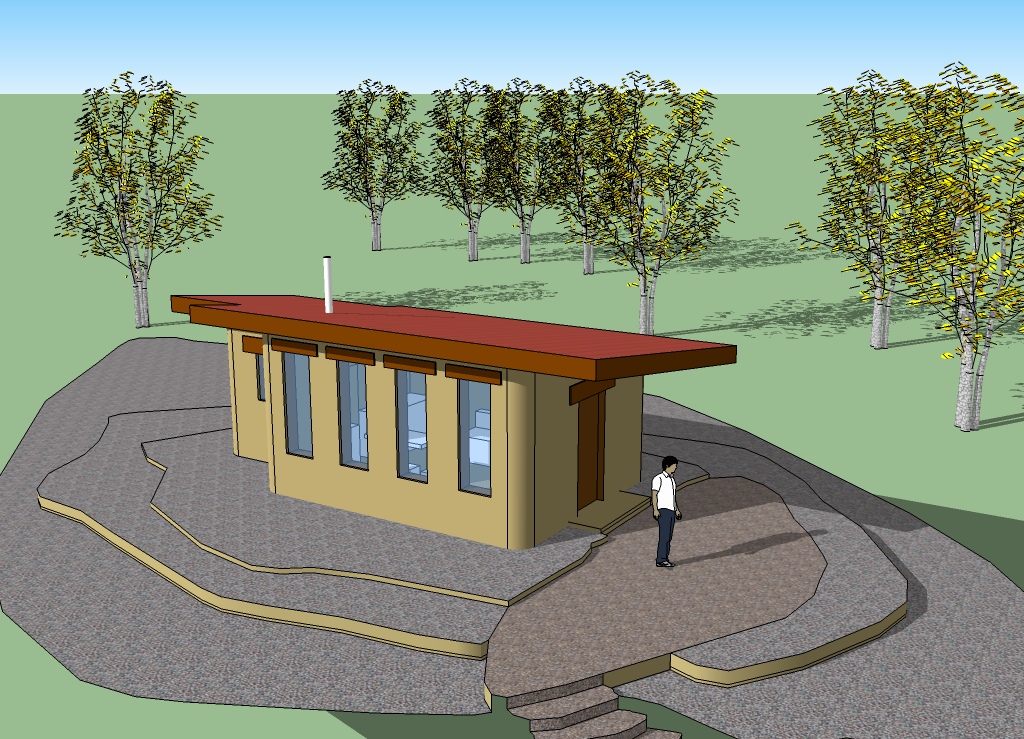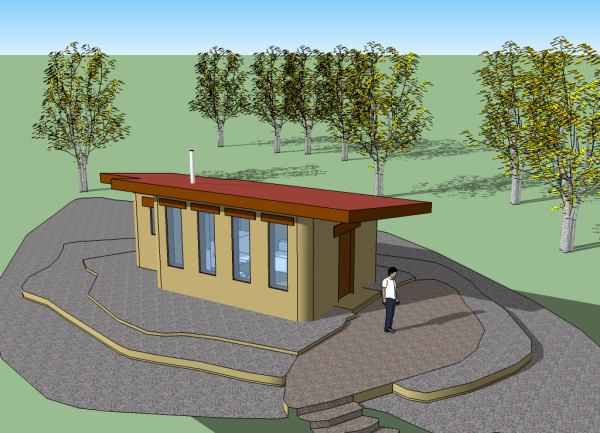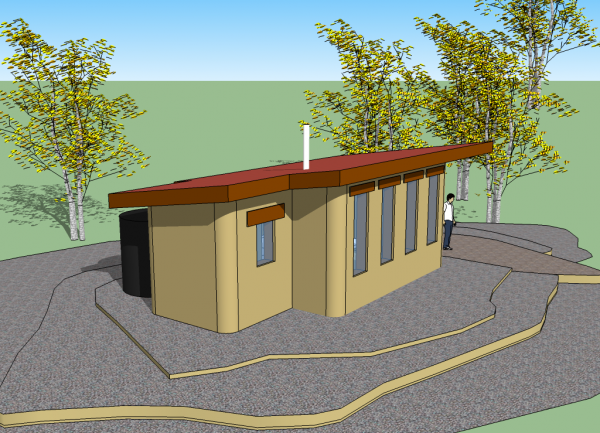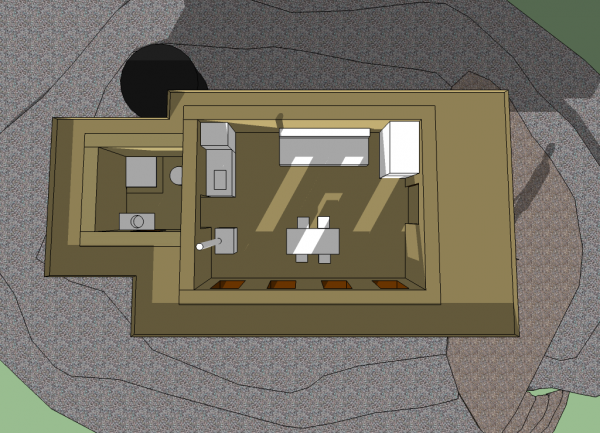When I first read about Ryo Chijiiwa’s tiny cabin on Tiny House Blog I was fascinated by the adventure this fellow was on. He quit his job at Google, traveled America, and is now working to setup a more comfortable place to live on the remote property that he recently purchased in northern California. You can read about it on his blog, Laptop and a Rifle.
But what I’ve been obsessing over for days is a simple solution that someone like Ryo could theoretically implement for a little money and a lot of sweat equity, an earthbag tiny house. Below is my earthbag daydream for simple sustainable living. The main room of the house is 12′ by 16′ and the bathroom is just 6′ by 6′.
The shed roof would send rainwater into a collection tank behind the house. It rains quite a bit in California but only for a few months out of the year. For a rain water collection system to work in this kind of climate you’d not only need to conserve water but you’d need to maximize your ability to collect and store whatever rain you could.
I’m imaging the toilet would be a sawdust composting toilet to reduce both water use and cost. Joseph Jenkins’ work in humanure has really paved the way for this ultra-sustainable method of dealing with poo. It sounds a bit gross to compost human waste but Jenkins has shown that it can be safe. The best part of a sawdust toilet is that no septic system or water source is needed, just some compost piles and water to wash out the buckets.
Earthbags are an amazing alternative to adobe, cob, and rammed earth. Basically earthbags are just sandbags filled with the dirt and sand under your feet. You stack them up like bricks and then mud the walls. That’s an extreme over-simplification but if it sounds interesting you can read about this construction method at great length at EarthbagBuilding.com.
In a situation like Ryo’s it seems like the ideal way to go. Virtually no water is needed during construction and the structure is mostly fireproof. Earthbags also provide tons of thermal mass making it much easier to maintain a comfortable interior temperature year round. I also suspect Ryo would find the bullet (and bear) proof characteristics of dirt walls a nice touch too 😉
Permits? Well… that’s why this is a day dream. I can totally see this being built in remote places where permits are not an issue. The main problem is that non-standard water and sewage systems are often not understood or allowed by planning departments. I’m not trying to deter anyone from working to make a daydream like this a reality… just suggesting that there will need to be some extra research and planning done before you start to fill the bags.





Permits may not be as much of a problem as you think. Most places now have permitting systems to allow for simple (and complex) greywater systems. Composting toilets have been around for years, so unless your water/sewer building codes have not been updated in the last 50 years, that should not be a problem either.
The part that worries me are the walls themselves. There is no way to know exactly what those bags have been filled with and mudded over so the inspectors can be difficult.
Still, a nice design if you live someplace that the soil works well for this. Ours is all red clay, so not a good choice.
JJ
Dude, you need more Lloyd Kahn in your life. The whole point of using earthbags (or any natural building technique) is that it is extremely flexible and you are not restricted to straight walls and boxy shapes – those were invented for ease of manufacturing from standard sized materials/ As nature doesn’t product standard sizes and shapes, these forms are not to be found in the ‘natural world’.
Earthbag design (which btw, can use clay instead of sand) imposes few restrictions on shapes. Free your mind of impure boxes. 🙂
I’ve been interested in earthbag homes for many years. Kelly Harts’ website has a wealth of info on his and many other homes “built with bags”. Kelly has also pioneered the method of filling the bags with insulative materials like porous lava rock (scoria) or per-lite.
Something I’ve been giving much thought to lately is using walls made with bags filled with scoria or perlite on the outside of an ISO shipping container home. Since the shipping container walls are steel, you could weld brackets on the side of the containers that would hold banding material that would hold the bag walls nice and tight against the containers.
I’ve made countless sketchup models of such homes – the possibilities are endless.
Craig Moorhouse
James… I guess it just goes to prove that no planning department is alike. I’m beginning to brainstorm a new online tool that would help people find communities that are friendly to these sort of alternative solutions. If you have any suggestions I’m all ears.
SteveR… I do need more Lloyd Kahn in my life 😀 His work is an incredible inspiration. I did actually start to draw circular and organic shapes but I’ve just not had much experience doing that in SketchUp. I’ll spend more time on that.
Craig… love to post some of your SketchUp concepts if you’re interested in sharing.
This is a very nice looking plan, but I’d have to have a modern bathroom. With my diabetas and high blood pressure being as bad as it is I have to take two baths a day during the summer.
too small